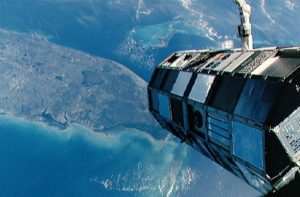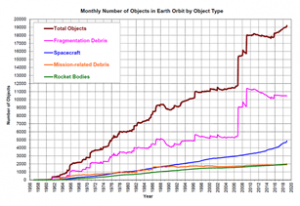With the dawn of the New Age Space Race between Blue Origin founded by Jeff Bezos and SpaceX founded by Elon Musk, it is of great importance to understand the implications of privatization of space for the general public. The development and progression of these companies pushes humanity leaps forward in engineering, aerospace research, potentially reducing costs of space travel, and space exploration. However, this explicitly implicates the generation of space debris and space pollution.
Space debris or space pollution are the objects and remains left in space that no longer serve any useful purpose. These often include satellite and spacecraft remains that are left in orbit after their initial objective is complete. These artificial objects continuously orbit Earth at increasingly higher velocities reaching speeds up to 11.7 km/s or 26,000 mph. With orbital velocities so high even the smallest particle collisions are violent. Even the smallest of particles could penetrate and rupture the hull and integrity of rockets.

With over 23,000 artificial objects in orbit, and each new collision potentially creating thousands more, leaving Earth’s orbit would become increasingly difficult. Kessler Syndrome was a term coined by the NASA scientist Donald J. Kessler in 1978, describing this feedback runaway cascade of objects in orbit colliding to further generate space debris. This could eventually produce a situation where the distribution of debris would render space activities incredibly difficult, potentially leading to physically impassable barriers to space exploration.

Since space debris has the potential to bring space exploration to a screeching halt, exceptional approaches are being developed and deployed to clear up our polluted skies. One such method is to use high-powered ground-based lasers to ablate the debris. Thus, vaporizing the debris instantaneously or slowing it down so that it may burn up in Earth’s atmosphere. In addition, Japan’s Japan Aerospace Exploration Agency (JAXA) had designed the use of “space net” satellites. The purpose of these is to trap and catch debris like a fishing net in space.
However, one common measure taken is the graveyard orbit. The United States Federal Communications Commission (FCC) requires all geostationary satellites at the end of the operational life be moved to the graveyard orbit, an altitude of over 36,000 km or 22,000 miles.
With space exploration once again booming, but this time among eccentric billionaires rather than national space agencies, maintaining and regulating Earth’s atmosphere and orbits becomes critical in guaranteeing space exploration for future generations.
Peer Edited by Morgan MCCullough